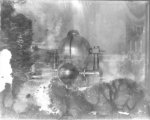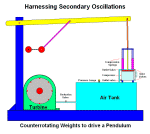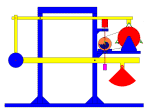







Keely's last Motor?
Was this the last Motor built by Keely?
May 4, 2007
 Jeff Behary has discovered what is in all likelyhood the photograph of the last motor Keely built. He found the photographic glass plate amongs 500 plates, virtually all of corona discharges taken by Thomas Burton Kinraide as part of his research into high frequency and high voltage coils. For more on the man look at Jeff's site: The Turn Of The Century Electrotherapy Museum
As you know Kinraide was entrusted with Keely's machines for evaluation after Keely's death. There seems little doubt the photo was taken by Kinraide himself.
Jeff Behary has discovered what is in all likelyhood the photograph of the last motor Keely built. He found the photographic glass plate amongs 500 plates, virtually all of corona discharges taken by Thomas Burton Kinraide as part of his research into high frequency and high voltage coils. For more on the man look at Jeff's site: The Turn Of The Century Electrotherapy Museum
As you know Kinraide was entrusted with Keely's machines for evaluation after Keely's death. There seems little doubt the photo was taken by Kinraide himself.
Secondary Oscillations
On first inspection this would appear a strange site to concern itself with things like the Milcovic type of device, a pendulum on a balance beam is hardly the stuff Keely concerned himself with. Not quite so, Keely's researches are all about vibratory physics, resonance and such. The Milkovic device actually functions the way it does because the same forces are at play here as in Keely's machines. The primary vibrations come from the oscillations of a pendulum, the rest is all resonance. I have long believed that if overunity can be found it will be in the realm of resonance, or sympathetic vibrations, as Keely called it.
I will from here on in devote a section of this site to devices that follow the same kind of technology. My new paper on harnessing secondary oscillations is but a start. The response to my first article was a surprise to me, 1500 hits on that article in one day alone, so the interest is there. Let me know what you think, any constructive ideas on the subject will be published here.
In the meantime, have fun with it, it might be worth it.
Hans von Lieven
Harnessing Secondary Oscillations
April 24, 2007
 This paper discusses secondary oscillations, the physics involved and suggested applications.
This paper discusses secondary oscillations, the physics involved and suggested applications.
It involves the use of counterrotating weights to energise the pendulum.
Just a few ideas to toss into the ring in relation to the "Milkovic Device"
April 9, 2007

In this article methods are discussed to provide efficient and accurate ways to energise the pendulum
as well as a suitable way to convert reciprocal movement into rotation.
The animation is a suggeted arrangement for a mechanical feedback system
that would turn the device into a perpetual motion machine.
It should not be taken too seriously. :-)
















 Jeff Behary has discovered what is in all likelyhood the photograph of the last motor Keely built. He found the photographic glass plate amongs 500 plates, virtually all of corona discharges taken by Thomas Burton Kinraide as part of his research into high frequency and high voltage coils. For more on the man look at Jeff's site: The Turn Of The Century Electrotherapy Museum
As you know Kinraide was entrusted with Keely's machines for evaluation after Keely's death. There seems little doubt the photo was taken by Kinraide himself.
Jeff Behary has discovered what is in all likelyhood the photograph of the last motor Keely built. He found the photographic glass plate amongs 500 plates, virtually all of corona discharges taken by Thomas Burton Kinraide as part of his research into high frequency and high voltage coils. For more on the man look at Jeff's site: The Turn Of The Century Electrotherapy Museum
As you know Kinraide was entrusted with Keely's machines for evaluation after Keely's death. There seems little doubt the photo was taken by Kinraide himself.
 This paper discusses secondary oscillations, the physics involved and suggested applications.
This paper discusses secondary oscillations, the physics involved and suggested applications.